Welcome to London Grip, a forum for reviews of books, shows & events – plus quarterly postings of new poetry. Our most recent posts are listed below. Older posts can be explored via the search box and topic list. For more information & guidelines on submitting reviews or poems please visit our Home page.
Pallant House Gallery, Chichester
Until April 21
Curated by Ian Collins
John Craxton managed to emerge from school without passing a single exam, not even in art. Instead, charm, daring, connections, irrepressible talent and luck served him better than any merely formal qualifications as he made his odyssey from the grey, war-time Britain he hated to Greece, which fulfilled his longing for the sun-lit south.
Undiagnosed TB meant he had a physical as well as spiritual need to escape the damp and smog. It also meant he failed his army medical and avoided conscription.
Exhibition curator and Craxton authority Ian Collins begins by setting out Craxton’s inspirations, benefactors, mentors, fellow artists and friends: notably Picasso, Graham Sutherland, Lucian Freud and Peter Watson, funder of Horizon magazine, which kept the flame of art and culture burning through the war years.
We are introduced to the man by two monochrome portraits – one by Craxton and one by Lucian Freud, who shared the “premises”, paid for by Watson, where the contemporaries developed their respective styles – too contrasting for them to clash – and outraged the neighbours.
We then survey some of the other works Craxton produced in 1940s Britain, but even then, the gloom is relieved by the humour, wit, irreverence, and the generosity of Craxton’s personality as conveyed by the exhibition notes, rich in anecdotal detail.
“The Loplop Bird and her Son” has irresistible appeal. It was drawn as a gift for artist and friend E.Q. Nicholson and pays tribute to Max Ernst for whom the loplop was one of his favourite alter egos. Craxton’s astute purchasing of a work by Ernst for £15, which he then sold, helped to fund the travels he craved. Selling his own work was another matter as we’re told he rarely bothered to even finish paintings.
Apart from the Surrealists, early influences were William Blake and Samuel Palmer as reflected in the nightmarish “Poet in a Landscape,” accomplished when Craxton was 19 and had just failed his army medical. The landscape’s romance is inverted and made menacing. The moon is not the lovers’, but the bombers’ friend, lighting their way as Craxton, depicted as a poet reading Blake, cowers in the foreground.
The horror of life in Britain is also conveyed by portrayals of some of the rotting game and poultry that helped to ensure uncomfortable relations with the neighbours as Freud, notorious for taking his time, allowed his subject matter to decompose before he finished painting it.
“Hare on a Table” for instance is packed with potential meaning: waste of life, waste of food in times of austerity and its reproachful, blue eyes evoke the southern sea for which Craxton longs and his identification with the lifeless piece of game.
Craxton, with the mentoring of Sutherland, was convinced art should create a new reality, not mimic nature, and by this measure, a hare can have eyes of any colour.
His transformation of the literal is especially vivid in his depiction of Alderholt Mill in Dorset.
Showing once again, his ability to land on his feet, Craxton, after being bombed out of the London family home, was taken in by E.Q. Nicholson and her family who lived at the mill.
Initially he portrayed his temporary refuge in war-time colourlessness, but then he came upon some samples of Ripolin enamel paint, as used by Picasso whom he revered. The result is forceful blue, red, yellow and green, such as Craxton imagined would surround him if only he could escape to Greece.
The exhibition recreates the exhilaration Craxton must have felt as we leave behind the darkness of England with the celebratory “Pastoral for P.W.” dedicated to his great benefactor Peter Watson.
In his new Mediterranean home, Craxton appears as Pan, dazzling in white, playing to the goats who are portraits of his friends. Freud, for instance, is the black one, digging his hooves in.
Apart from goats, which appear again and again, Craxton paints the ordinary and yet extraordinary people of Greece, whose lineage he traced to antique times.
He particularly loved depicting sailors and another standout of the exhibition is “Still Life Sailors” – a celebration of eating, drinking, smoking and the sheer joy of being alive. The accompanying note tells us Craxton’s favourite sound was friends talking over a meal, which he loved even more than the purring of cats.
Overwhelmingly, Craxton’s chosen subjects are male. His portrait of Sonia Leon is a glorious exception.
He met her on the way to the Isles of Scilly, which he and Freud visited as the closest thing Britain could get to Greece. Both Freud and Craxton had begged her to sit for them and she eventually agreed to pose for Craxton, believing, we’re told, he worked more quickly than Freud. Ironically, it took him a decade to complete his portrayal of her luminous beauty, but her patience was rewarded: he presented it to her as a wedding gift when she married the writer Peter Quennell.
In all, the exhibition includes more than 100 works in varying degrees of completion because for Craxton, the most important art was that of living life to the full.
John Craxton: A Modern Odyssey.
Pallant House Gallery, Chichester
Until April 21
Curated by Ian Collins
John Craxton managed to emerge from school without passing a single exam, not even in art. Instead, charm, daring, connections, irrepressible talent and luck served him better than any merely formal qualifications as he made his odyssey from the grey, war-time Britain he hated to Greece, which fulfilled his longing for the sun-lit south.
Undiagnosed TB meant he had a physical as well as spiritual need to escape the damp and smog. It also meant he failed his army medical and avoided conscription.
Exhibition curator and Craxton authority Ian Collins begins by setting out Craxton’s inspirations, benefactors, mentors, fellow artists and friends: notably Picasso, Graham Sutherland, Lucian Freud and Peter Watson, funder of Horizon magazine, which kept the flame of art and culture burning through the war years.
We are introduced to the man by two monochrome portraits – one by Craxton and one by Lucian Freud, who shared the “premises”, paid for by Watson, where the contemporaries developed their respective styles – too contrasting for them to clash – and outraged the neighbours.
We then survey some of the other works Craxton produced in 1940s Britain, but even then, the gloom is relieved by the humour, wit, irreverence, and the generosity of Craxton’s personality as conveyed by the exhibition notes, rich in anecdotal detail.
“The Loplop Bird and her Son” has irresistible appeal. It was drawn as a gift for artist and friend E.Q. Nicholson and pays tribute to Max Ernst for whom the loplop was one of his favourite alter egos. Craxton’s astute purchasing of a work by Ernst for £15, which he then sold, helped to fund the travels he craved. Selling his own work was another matter as we’re told he rarely bothered to even finish paintings.
Apart from the Surrealists, early influences were William Blake and Samuel Palmer as reflected in the nightmarish “Poet in a Landscape,” accomplished when Craxton was 19 and had just failed his army medical. The landscape’s romance is inverted and made menacing. The moon is not the lovers’, but the bombers’ friend, lighting their way as Craxton, depicted as a poet reading Blake, cowers in the foreground.
The horror of life in Britain is also conveyed by portrayals of some of the rotting game and poultry that helped to ensure uncomfortable relations with the neighbours as Freud, notorious for taking his time, allowed his subject matter to decompose before he finished painting it.
“Hare on a Table” for instance is packed with potential meaning: waste of life, waste of food in times of austerity and its reproachful, blue eyes evoke the southern sea for which Craxton longs and his identification with the lifeless piece of game.
Craxton, with the mentoring of Sutherland, was convinced art should create a new reality, not mimic nature, and by this measure, a hare can have eyes of any colour.
His transformation of the literal is especially vivid in his depiction of Alderholt Mill in Dorset.
Showing once again, his ability to land on his feet, Craxton, after being bombed out of the London family home, was taken in by E.Q. Nicholson and her family who lived at the mill.
Initially he portrayed his temporary refuge in war-time colourlessness, but then he came upon some samples of Ripolin enamel paint, as used by Picasso whom he revered. The result is forceful blue, red, yellow and green, such as Craxton imagined would surround him if only he could escape to Greece.
The exhibition recreates the exhilaration Craxton must have felt as we leave behind the darkness of England with the celebratory “Pastoral for P.W.” dedicated to his great benefactor Peter Watson.
In his new Mediterranean home, Craxton appears as Pan, dazzling in white, playing to the goats who are portraits of his friends. Freud, for instance, is the black one, digging his hooves in.
Apart from goats, which appear again and again, Craxton paints the ordinary and yet extraordinary people of Greece, whose lineage he traced to antique times.
He particularly loved depicting sailors and another standout of the exhibition is “Still Life Sailors” – a celebration of eating, drinking, smoking and the sheer joy of being alive. The accompanying note tells us Craxton’s favourite sound was friends talking over a meal, which he loved even more than the purring of cats.
Overwhelmingly, Craxton’s chosen subjects are male. His portrait of Sonia Leon is a glorious exception.
He met her on the way to the Isles of Scilly, which he and Freud visited as the closest thing Britain could get to Greece. Both Freud and Craxton had begged her to sit for them and she eventually agreed to pose for Craxton, believing, we’re told, he worked more quickly than Freud. Ironically, it took him a decade to complete his portrayal of her luminous beauty, but her patience was rewarded: he presented it to her as a wedding gift when she married the writer Peter Quennell.
In all, the exhibition includes more than 100 works in varying degrees of completion because for Craxton, the most important art was that of living life to the full.
Barbara Lewis © 2024.
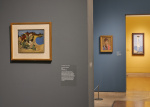
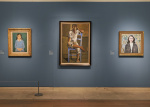
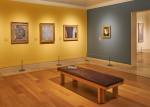
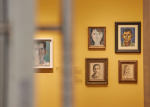
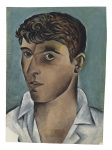
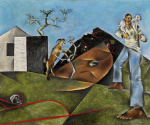
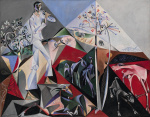
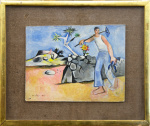
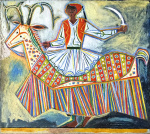
























By Barbara Lewis • art, exhibitions, painting, year 2024 • Tags: art, Barbara Lewis, exhibitions, painting